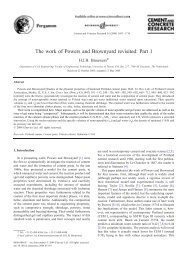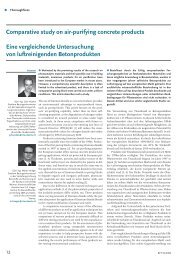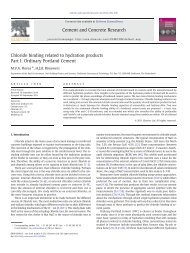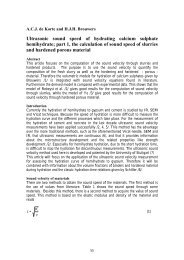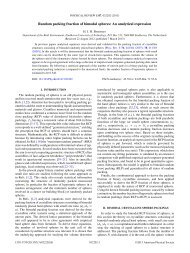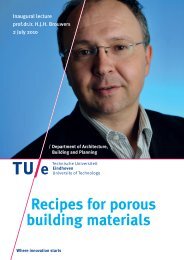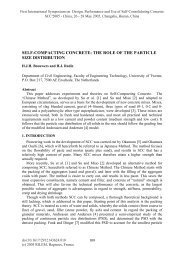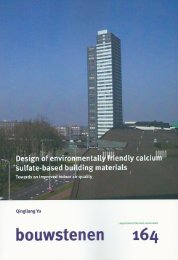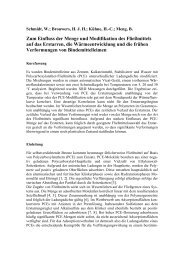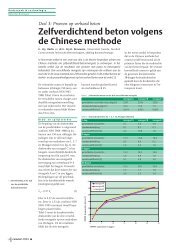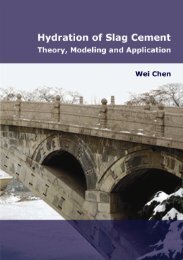RCM: A new model accounting for the non-linear ... - Jos Brouwers
RCM: A new model accounting for the non-linear ... - Jos Brouwers
RCM: A new model accounting for the non-linear ... - Jos Brouwers
You also want an ePaper? Increase the reach of your titles
YUMPU automatically turns print PDFs into web optimized ePapers that Google loves.
296 P. Spiesz et al. / Construction and Building Materials 27 (2012) 293–304<br />
dm 3 or 2.48 g/dm 3 ). Inserting Eq. (9) into Eq. (8) and solving <strong>for</strong> <strong>the</strong><br />
D<strong>RCM</strong> gives as follows [1]:<br />
D<strong>RCM</strong> ¼ RTL xd a<br />
zFU<br />
ffiffiffiffi p<br />
xd<br />
: ð11Þ<br />
t<strong>RCM</strong><br />
The output of <strong>the</strong> test – D<strong>RCM</strong> is a chloride ion transport parameter<br />
in concrete, expressed in m 2 /s and t<strong>RCM</strong> is <strong>the</strong> final duration of<br />
<strong>the</strong> migration test.<br />
2.3. Verification of <strong>the</strong> traditional <strong>the</strong>oretical <strong>model</strong> <strong>for</strong> <strong>the</strong> <strong>RCM</strong> test<br />
As mentioned earlier, an abrupt free-chloride concentration<br />
profile (see Fig. 2) represents <strong>the</strong> solution of <strong>the</strong> chloride transport<br />
<strong>model</strong> developed in [1]. However, in practice it is very difficult to<br />
measure <strong>the</strong> free-chloride concentration profile in concrete, so<br />
usually only <strong>the</strong> total chloride concentration is measured.<br />
Although <strong>the</strong> <strong>the</strong>oretical free- and total chloride concentration profiles<br />
are not equal to each o<strong>the</strong>r when bound-chlorides are present<br />
in concrete, <strong>the</strong>y hypo<strong>the</strong>tically should have <strong>the</strong> same shape if <strong>the</strong><br />
assumptions of <strong>linear</strong> chloride binding iso<strong>the</strong>rm and instantaneous<br />
equilibrium in <strong>the</strong> traditional <strong>RCM</strong> <strong>model</strong> were correct (see Eq.<br />
(4)).<br />
Several researchers have presented <strong>the</strong> experimental total chloride<br />
concentration profiles measured in concrete after <strong>the</strong> migration<br />
tests [1,8,9,12–16]. Table 1 shows <strong>the</strong> concrete mix proportions and<br />
<strong>the</strong> <strong>RCM</strong> test conditions <strong>for</strong> which <strong>the</strong> chloride concentration profiles<br />
were measured by Stanish [12] and Yuan [9]. One of <strong>the</strong>se<br />
<strong>RCM</strong> profiles [9] and an additional natural diffusion test profile<br />
(42 days exposure to chlorides), both measured <strong>for</strong> <strong>the</strong> same concrete<br />
(C4 in Table 1), are shown in Fig. 3. Clearly, <strong>the</strong> reported gradual<br />
experimental profiles after <strong>the</strong> <strong>RCM</strong> test are much different in shape<br />
in comparison to <strong>the</strong> <strong>the</strong>oretical ‘tsunami’ profile presented in Fig. 2,<br />
and very similar in fact to chloride profiles measured in concrete<br />
after natural diffusion exposure to chlorides. This difference between<br />
<strong>the</strong> <strong>the</strong>ory and <strong>the</strong> experimental measurements gives evidence<br />
that <strong>the</strong> current chloride transport <strong>model</strong> <strong>for</strong> <strong>the</strong> <strong>RCM</strong> test<br />
unsatisfactorily describes <strong>the</strong> real process. There<strong>for</strong>e, <strong>the</strong> D <strong>RCM</strong> calculated<br />
based on <strong>the</strong> Eq. (11) should be treated carefully.<br />
Tang in [1] gives a few possible explanations <strong>for</strong> <strong>the</strong> difference<br />
between <strong>the</strong> <strong>the</strong>oretical and experimental chloride profiles, such as<br />
(a) different pore distribution resulting in different penetration<br />
front; (b) reaction kinetics which changes <strong>the</strong> shape of <strong>the</strong> profile<br />
without changing <strong>the</strong> penetration depth or (c) <strong>the</strong> influence of<br />
o<strong>the</strong>r ions on <strong>the</strong> chloride binding. These are sound arguments,<br />
but <strong>the</strong> ef<strong>for</strong>ts taken so far in order to develop a chloride migration<br />
Table 1<br />
Testing conditions and properties of concrete.<br />
Fig. 3. Experimental total chloride concentration profile in concrete after <strong>the</strong><br />
migration and diffusion tests <strong>for</strong> concrete C4 [9].<br />
<strong>model</strong> which predicts well <strong>the</strong> experimental profile (e.g. including<br />
<strong>the</strong> reaction kinetics or developing multi-species <strong>model</strong>s <strong>for</strong> a combined<br />
diffusion-migration process) were unsatisfying. Fur<strong>the</strong>rmore,<br />
o<strong>the</strong>r possible explanations can be added to <strong>the</strong> list.<br />
As previously stated, <strong>the</strong> chloride concentration profile shown<br />
in Fig. 2 results from Eq. (7), in which <strong>the</strong> assumptions of <strong>the</strong> <strong>linear</strong><br />
binding iso<strong>the</strong>rm and equilibrium between free- and bound-chlorides<br />
are introduced. However, as will be explained in <strong>the</strong> next Section,<br />
chloride binding in concrete is a <strong>non</strong>-<strong>linear</strong> process and <strong>the</strong><br />
equilibrium between free- and bound-chlorides cannot be<br />
achieved within such a short period of time as <strong>the</strong> duration of<br />
<strong>the</strong> <strong>RCM</strong> test. There<strong>for</strong>e, <strong>the</strong> authors present a <strong>new</strong> simplified chloride<br />
transport <strong>model</strong>, which can properly predict <strong>the</strong> behaviour of<br />
chlorides migrating into concrete. This <strong>new</strong> <strong>model</strong> includes among<br />
o<strong>the</strong>rs <strong>the</strong> <strong>non</strong>-<strong>linear</strong> binding iso<strong>the</strong>rm and <strong>non</strong>-equilibrium conditions<br />
between free- and bound-chlorides.<br />
3. Chloride binding<br />
When chloride ions penetrate concrete, part of <strong>the</strong>m can be captured<br />
and immobilized by <strong>the</strong> hydration products of cement. This<br />
process of interaction between <strong>the</strong> chloride ions and cement hydrates<br />
– so-called chloride binding – can take place in two ways:<br />
by chemical reaction (with calcium aluminate hydrates) or physical<br />
adsorption (on <strong>the</strong> surface of <strong>the</strong> C–S–H gel). Never<strong>the</strong>less, it<br />
is very difficult in practice to distinguish between <strong>the</strong> chlorides<br />
Concrete code C1 C2 C3 C4 C5<br />
Reference [12] [12] [9] [9] [9]<br />
w/c 0.35 0.45 0.35 0.48 0.60<br />
Cement type T10 T10 Cem I 52.5 N Cem I 52.5 N Cem I 52.5 N<br />
(kg/m 3 ) 418 362.5 400 380 363<br />
Water (kg/m 3 ) 146 163 140 182 218<br />
Coarse aggregates (kg/m 3 ) 1025 1025 1281 1217 1162<br />
Sand (kg/m 3 ) 695 698 660 627 599<br />
Additives Air entrainer, superplasticizer Air entrainer Water reducer – –<br />
rc (56 days) (MPa) 52 33 81.7 46.7 37.9<br />
Age (months) 12–18 12–18 2 2 2<br />
t<strong>RCM</strong> (h) 6, 9 and 18 6, 9 and 18 24 24 24<br />
qc (kg/m 3 ) 2577 2553 2637 2608 2584<br />
qs (kg/m 3 ) 2601 2606 2665 2661 2643<br />
U (V) 60 60 35 25 20<br />
c0 (g/dm 3 ) 70.9 70.9 70.9 70.9 70.9<br />
L (m) 0.05 0.05 0.05 0.05 0.05<br />
u (%) 11.3 14.3 10.2 14.1 15



